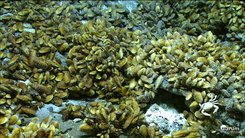Hydrogen highway in the deep sea
Max Planck Researchers discover hydrogen-powered symbiotic bacteria in deep-sea hydrothermal vent mussels
The search for new energy sources to power mankind’s increasing needs is currently a topic of immense interest. Hydrogen-powered fuel cells are considered one of the most promising clean energy alternatives. While intensive research efforts have gone into developing ways to harness hydrogen energy to fuel our everyday lives, a natural example of a living hydrogen-powered ‘fuel cell’ has gone unnoticed. During a recent expedition to hydrothermal vents in the deep sea, researchers from the Max Planck Institute of Marine Microbiology and the Cluster of Excellence MARUM discovered mussels that have their own on-board ‘fuel cells’, in the form of symbiotic bacteria that use hydrogen as an energy source. Their results, which appear in the current issue of Nature, suggest that the ability to use hydrogen as a source of energy is widespread in hydrothermal vent symbioses.
The discovery began at the Logatchev hydrothermal vent field, at 3000 m depth on the Mid-Atlantic Ridge, an undersea mountain range halfway between the Caribbean and the Cape Verde Islands. The highest hydrogen concentrations ever measured at hydrothermal vents were recorded during a series of research expeditions to Logatchev. According to Jillian Petersen, a researcher with Nicole Dubilier, “our calculations show that at this hydrothermal vent, hydrogen oxidation could deliver seven times more energy than methane oxidation, and up to 18 times more energy than sulfide oxidation”.

In the gills of the deep-sea mussel Bathymodiolus puteoserpentis, one of the most abundant animals at Logatchev, the researchers discovered a sulfur-oxidizing symbiont that can also use hydrogen as an energy source. To track down these hydrogen-powered on-board ‘fuel cells’ in the deep-sea mussels, the researchers deployed two deep-sea submersibles, MARUM-QUEST from MARUM at the University of Bremen, and KIEL 6000 from IFM-GEOMAR in Kiel. With the help of these remotely-driven submersibles, they sampled mussels from sites kilometers below the sea surface. Their ship-board experiments with live samples showed that the mussels consumed hydrogen. Once the samples were back in the laboratory on land, they were able to identify the mussel symbiont hydrogenase, the key enzyme for hydrogen oxidation, using molecular techniques.
The mussel beds at Logatchev form a teeming expanse that covers hundreds of square meter and contains an estimated half a million mussels. “Our experiments show that this mussel population could consume up to 5000 liters of hydrogen per hour” according to Frank Zielinski, a former doctoral student in Nicole Dubilier’s Group in Bremen, who now works as a post-doctoral researcher at the Helmholtz Centre for Environmental Research in Leipzig. The deep-sea mussel symbionts therefore play a substantial role as the primary producers responsible for transforming geofuels to biomass in these habitats. “The hydrothermal vents along the mid-ocean ridges that emit large amounts of hydrogen can therefore be likened to a hydrogen highway with fuelling stations for symbiotic primary production” says Jillian Petersen.
Even the symbionts of other hydrothermal vent animals such as the giant tubeworm Riftia pachyptila and the shrimp Rimicaris exoculata have the key gene for hydrogen oxidation, but remarkably, this had not been previously recognized. “The ability to use hydrogen as an energy source seems to be widespread in these symbioses, even at hydrothermal vent sites with low amounts of hydrogen” says Nicole Dubilier.
This study was supported by the Max Planck Society, the German Research Foundation (Priority program 1144: “From Mantle to Ocean: Energy-, Material- and Life Cycles at Spreading Axes’’), and the Cluster of Excellence “The Ocean in the Earth System” at MARUM, Bremen.
